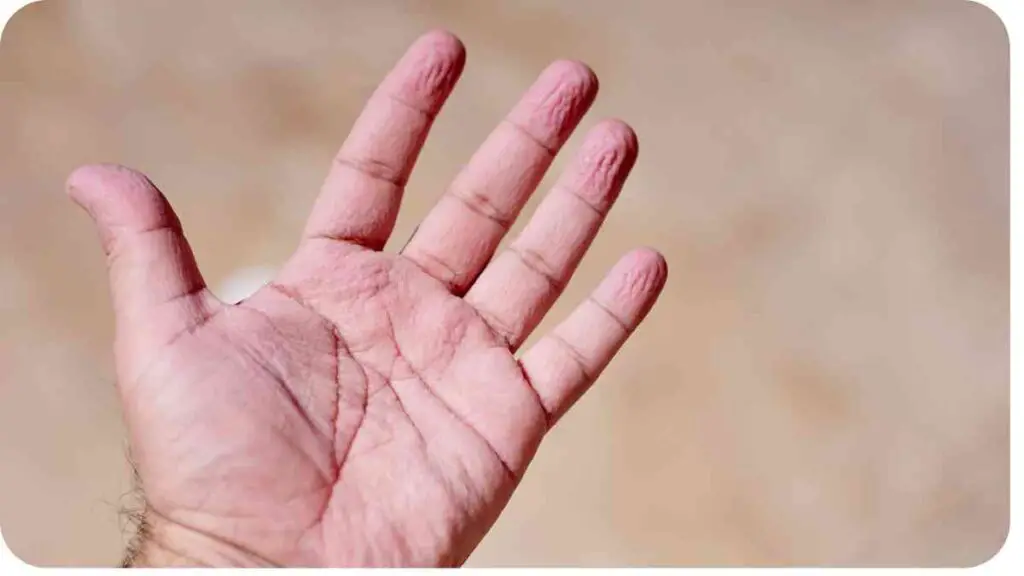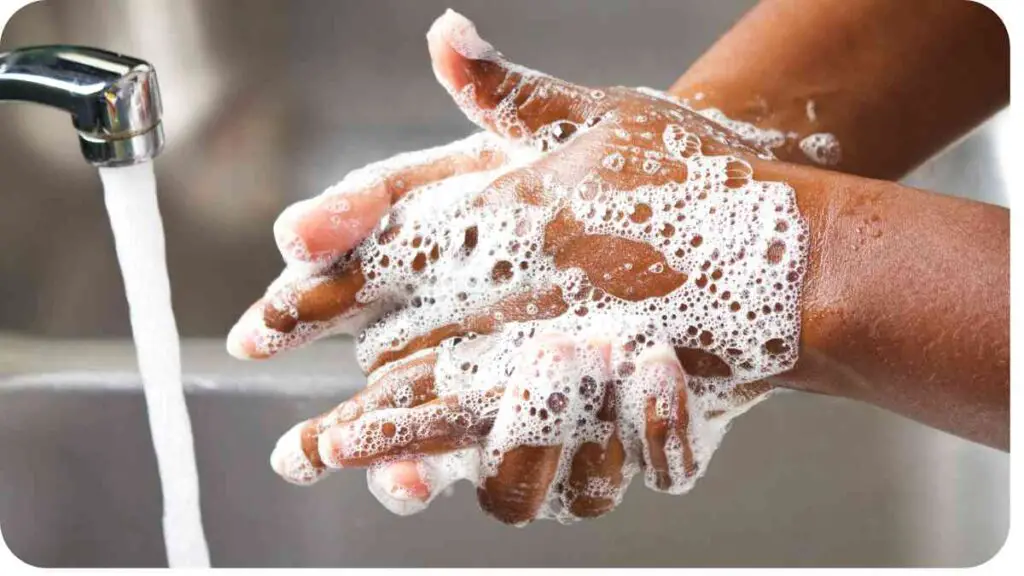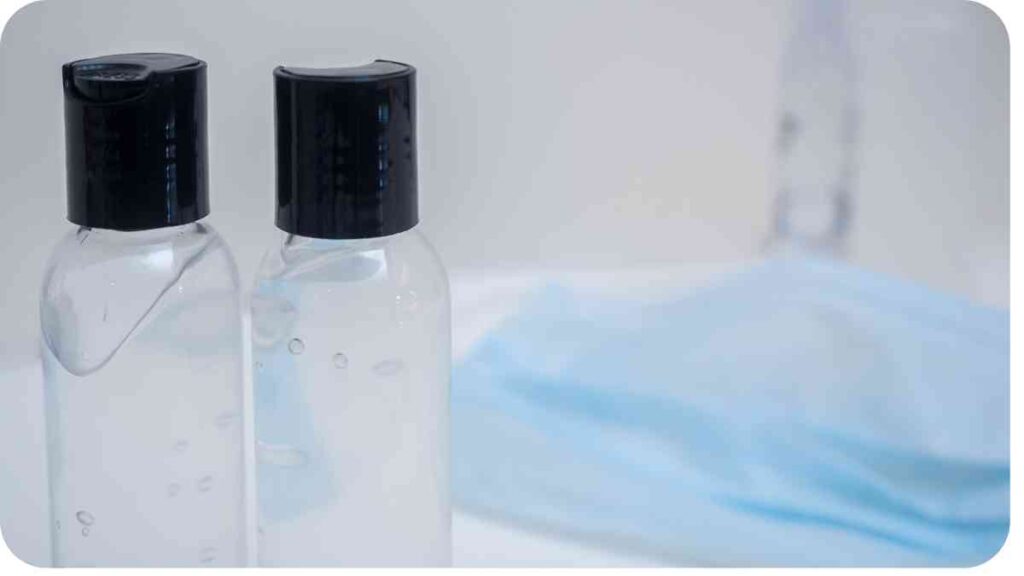Have you ever wondered why your fingers and toes get wrinkled after soaking in water for a while? This phenomenon, known as pruney digits, has puzzled scientists and intrigued curious minds for decades.
In this article, we’ll delve into the science behind pruney digits from waterlogging, exploring the underlying mechanisms, debunking myths, and discussing practical implications.
| Takeaways |
|---|
| Pruney digits are a result of a combination of water absorption by the skin and a neurological response that causes blood vessels to constrict. |
| Contrary to popular belief, pruney fingers are not necessarily a sign of dehydration but rather a natural physiological response to water immersion. |
| Understanding the factors influencing pruney digits, such as water temperature, duration of immersion, and individual variability, can help minimize their occurrence. |
| Pruney digits may serve an evolutionary purpose by enhancing grip and tactile sensation in wet conditions, potentially providing a survival advantage to our ancestors. |
| Managing pruney digits involves preventive measures such as limiting water exposure, using protective gear, maintaining proper hydration, and monitoring skin health. |
2. Understanding Pruney Digits

Pruney digits refer to the wrinkling of the skin on our fingers, toes, and other extremities after prolonged exposure to water. This wrinkling typically occurs within minutes of immersion and is more pronounced in areas with thinner skin, such as fingertips. While it may seem like a mere cosmetic nuisance, pruney digits serve a fascinating biological purpose.
Understanding the phenomenon of wrinkling in water provides insights into human physiology and aquatic adaptation. As explored in Why Do Fingers and Toes Wrinkle in Water?, this process unveils the intricate mechanisms behind this common occurrence.
| Factors | Effects |
|---|---|
| Water Absorption | Increased skin hydration |
| Neurological Response | Contraction of blood vessels |
| Evolutionary Advantage | Enhanced grip in wet conditions |
Pruney digits are often associated with a loss of grip and dexterity, but research suggests otherwise. In fact, wrinkled fingers may improve our ability to manipulate wet objects, providing a better grip in slippery conditions. This evolutionary adaptation could have conferred a survival advantage to our ancestors when foraging for food or navigating wet environments.
3. The Role of Skin in Waterlogging
To understand why our skin wrinkles in response to water, it’s essential to examine the structure and function of the skin itself. The outermost layer of our skin, known as the epidermis, is composed of multiple layers of cells, including keratinocytes. Beneath the epidermis lies the dermis, which contains blood vessels, nerves, and appendages such as hair follicles and sweat glands.
When we immerse our hands or feet in water, the outer layer of the skin absorbs moisture, causing it to swell. This swelling, known as water absorption, is primarily driven by osmosis, the movement of water molecules from an area of low solute concentration to an area of high solute concentration. As a result, the cells in the epidermis become engorged with water, leading to temporary changes in their appearance and texture.
The neurological response to water immersion also plays a crucial role in the formation of pruney digits. Research suggests that the autonomic nervous system, which controls involuntary bodily functions, including blood flow, plays a key role in regulating skin wrinkling. Specifically, the sympathetic nervous system triggers the constriction of blood vessels in the skin, reducing blood flow to the affected areas.
This vasoconstriction is thought to be an adaptive response to prolonged water exposure, helping to conserve body heat and maintain thermal regulation. By restricting blood flow to the skin’s surface, the body can minimize heat loss and preserve core body temperature, particularly in cold water environments.
As a result of this neurological response, the skin’s surface becomes less pliable, leading to the characteristic wrinkling associated with pruney digits. Interestingly, recent studies have suggested that the same neurological pathways responsible for skin wrinkling may also play a role in regulating grip strength and tactile sensation in wet conditions.
4. Factors Influencing Pruney Digits

While water immersion is the primary trigger for pruney digits, several factors can influence the extent and duration of skin wrinkling. These factors include:
Pruning not only shapes plants but also stimulates growth and resilience. Discover more about this practice and its effects in the article Unlocking the Growth-Boosting Power of Pruning: What’s the Trick? to delve deeper into plant physiology.
Temperature:
- Warmer water temperatures tend to accelerate the onset of pruney digits, as higher temperatures enhance water absorption and vasodilation.
- Conversely, colder water temperatures may delay or reduce skin wrinkling due to vasoconstriction and decreased water absorption.
Duration of Immersion:
- The longer the exposure to water, the more pronounced the wrinkling effect. Prolonged immersion can lead to more significant changes in skin texture and appearance.
Skin Thickness:
- Areas of the body with thinner skin, such as the fingertips and toes, tend to exhibit more noticeable wrinkling compared to thicker-skinned areas.
Individual Variability:
- The degree of skin wrinkling can vary significantly among individuals, depending on factors such as age, hydration levels, and overall skin health.
Understanding these factors can help explain why some people experience more severe pruney digits than others and why the extent of wrinkling may vary under different environmental conditions.
| Factors | Effects |
|---|---|
| Temperature | Warmer water accelerates pruney digits |
| Duration of Immersion | Longer exposure leads to more pronounced wrinkling |
| Skin Thickness | Thinner skin areas exhibit more noticeable wrinkling |
| Individual Variability | Degree of wrinkling varies among individuals |
5. Myth vs. Reality: Debunking Common Misconceptions
Despite decades of scientific research, several myths and misconceptions surround pruney digits. Let’s debunk some of the most common myths:
Myth: Pruney Skin Is Caused by Water Absorption.
Reality: While water absorption plays a role in pruney skin, the neurological response mediated by the autonomic nervous system is equally important. Vasoconstriction of blood vessels contributes to the wrinkling effect by reducing blood flow to the skin’s surface.
Bonsai trees defy conventional expectations, thriving for centuries in tiny pots. Learn about the secrets behind their longevity in What’s the Secret to Bonsai’s Centuries-Old Longevity in Tiny Pots? and uncover the remarkable adaptability of these miniature wonders
Myth: Pruney Skin Indicates Dehydration.
Reality: Contrary to popular belief, pruney skin is not necessarily a sign of dehydration. The wrinkling response is primarily a neurological phenomenon triggered by water immersion, rather than a direct indicator of hydration status.
Myth: Pruney Skin Is Harmful.
Reality: Pruney skin is a temporary and reversible condition that typically resolves once the skin is dry. While prolonged exposure to water can increase the risk of skin maceration and infection, temporary wrinkling itself is not harmful and serves a functional purpose in enhancing grip and dexterity.
By dispelling these myths, we can gain a better understanding of the science behind pruney digits and appreciate the intricate mechanisms at play.
6. The Evolutionary Perspective
The phenomenon of pruney digits raises intriguing questions about its evolutionary origins and adaptive significance. Why would our bodies develop a response that causes our skin to wrinkle when immersed in water? Researchers have proposed several hypotheses to explain the evolutionary purpose of pruney digits:
Enhanced Grip:
- One prevailing theory suggests that wrinkled fingers and toes may have conferred an evolutionary advantage by improving grip and traction in wet environments. This enhanced grip would have been particularly beneficial for our ancestors when gathering food from aquatic sources or navigating slippery terrain.
Tactile Sensation:
- Another hypothesis proposes that pruney digits may enhance tactile sensation by increasing the surface area of the fingertips. The wrinkled skin may provide better traction and sensitivity, allowing for more precise manipulation of objects underwater.
Trees exhibit remarkable growth patterns influenced by environmental cues. Explore the intricacies of their branching behavior in How Do Trees Know When to Start Branching Out as They Grow? to gain insights into the underlying mechanisms of plant development.
Protection Against Maceration:
- Pruney skin may also serve a protective function by reducing the risk of skin maceration and injury during prolonged water exposure. The wrinkles act as channels to channel water away from the skin’s surface, preventing excessive softening and damage.
While these hypotheses offer compelling explanations for the adaptive significance of pruney digits, further research is needed to fully understand their evolutionary origins. Nevertheless, the presence of this phenomenon across diverse human populations suggests that pruney digits may have conferred a survival advantage in ancestral environments.
7. Practical Implications: Health Effects of Pruney Digits
While pruney digits are often dismissed as a harmless side effect of water exposure, they can have practical implications for skin health and hygiene. Prolonged immersion in water can lead to maceration, a condition characterized by softening and breakdown of the skin due to excessive moisture.
| Condition | Symptoms | Prevention |
|---|---|---|
| Skin Maceration | Softening, redness, and irritation of the skin | Limit exposure to water, use waterproof gloves or footwear |
Skin maceration creates an ideal environment for bacterial and fungal growth, increasing the risk of infections such as athlete’s foot and trench foot. Therefore, it’s essential to take precautions to prevent prolonged water exposure and maintain proper skin hygiene, especially in moist environments.
In addition to skin maceration, individuals with pre-existing skin conditions, such as eczema or psoriasis, may experience exacerbation of symptoms due to pruney digits. The prolonged moisture exposure can irritate sensitive skin and trigger inflammatory reactions, leading to discomfort and flare-ups.
By understanding the potential health effects of pruney digits, individuals can take proactive measures to protect their skin and minimize the risk of complications associated with prolonged water exposure.
8. How to Prevent Pruney Digits

While pruney digits are a natural physiological response to water immersion, there are steps you can take to minimize their occurrence and mitigate potential risks:
Limit Water Exposure:
- Avoid prolonged immersion in water, especially in environments where skin wrinkling is more likely to occur, such as swimming pools or hot tubs.
Use Protective Gear:
- Wear waterproof gloves or footwear when engaging in activities that involve prolonged water exposure, such as washing dishes or gardening.
Maintain Skin Hygiene:
- After water exposure, gently pat the skin dry with a soft towel and apply moisturizer to prevent excessive drying and irritation.
Monitor Skin Health:
- Pay attention to any changes in skin texture or appearance, such as redness, itching, or inflammation, and seek medical attention if necessary.
By taking these preventive measures, you can minimize the risk of pruney digits and promote overall skin health and hygiene.
Trimming plants isn’t just about aesthetics; it promotes strength and vitality. Delve into the reasons behind this phenomenon in Why Does Trimming Plants Make Them Grow Stronger? and uncover the secrets to fostering robust plant growth.
9. Hydration and Skin Health
While pruney digits are often associated with water immersion, maintaining proper hydration is essential for overall skin health. Dehydration can lead to dry, cracked skin, making it more susceptible to damage and infection. Therefore, staying hydrated is crucial for maintaining skin elasticity and integrity.
Importance of Hydration:
- Drinking an adequate amount of water helps keep the skin hydrated from the inside out, reducing the risk of dryness and irritation.
- In addition to water, consuming foods rich in water content, such as fruits and vegetables, can contribute to overall hydration levels.
Impact on Skin Aging:
- Chronic dehydration can accelerate the signs of aging, including fine lines, wrinkles, and sagging skin. Proper hydration helps maintain skin firmness and elasticity, promoting a youthful appearance.
Tips for Hydrated Skin:
- Aim to drink at least eight glasses of water per day, or more if you’re physically active or live in a hot climate.
- Use moisturizers containing hydrating ingredients such as hyaluronic acid or glycerin to lock in moisture and prevent water loss from the skin.
By prioritizing hydration, you can support healthy skin function and minimize the risk of dryness and other dermatological issues.
10. Pruney Digits in Different Environments
While pruney digits are commonly observed during water immersion, they can also occur in other environments with high humidity or moisture levels. Here’s how pruney digits manifest in various settings:
Swimming Pools:
- Prolonged exposure to chlorinated water in swimming pools can cause pruney digits, especially if the water temperature is warm.
- Chlorine and other pool chemicals can strip the skin of its natural oils, contributing to dryness and irritation.
Hot Tubs and Spas:
- Soaking in hot tubs or spas for an extended period can lead to pruney digits due to the combination of hot water and steam.
- The heat from hot tubs can cause vasodilation and increased water absorption, exacerbating skin wrinkling.
Bathing:
- Taking long baths or showers, particularly with hot water, can result in pruney digits, as prolonged exposure to water can compromise the skin’s barrier function.
- Using gentle cleansers and limiting bath time can help minimize the risk of skin dehydration and irritation.
Rainy Weather:
- Exposure to rainwater or high humidity levels during rainy weather can also cause pruney digits, especially if the skin remains wet for an extended period.
- Wearing waterproof clothing and drying off promptly after exposure to rain can help prevent excessive skin wrinkling.
By understanding how pruney digits manifest in different environments, you can take proactive measures to protect your skin and minimize the risk of prolonged wrinkling.
11. Pruney Digits and Aquatic Activities
For individuals who frequently engage in aquatic activities such as swimming, diving, or water sports, pruney digits are a common occurrence. However, understanding how to manage pruney digits during these activities can help optimize performance and prevent discomfort.
Grip Enhancement:
- Contrary to popular belief, pruney digits may actually improve grip and traction in wet conditions, providing better control and stability when handling objects underwater.
- Athletes and divers can leverage the enhanced grip of pruney fingers to maintain a secure hold on equipment and surfaces.
Skin Protection:
- Despite the potential benefits of pruney digits, prolonged water exposure can increase the risk of skin maceration and infection, particularly in aquatic environments with high bacterial loads.
- Wearing protective gloves or footwear can help minimize skin contact with water and reduce the risk of skin damage.
Hydration Management:
- Maintaining proper hydration levels during aquatic activities is crucial for overall performance and endurance.
- Drink plenty of water before, during, and after swimming or diving to prevent dehydration and support optimal skin function.
Post-Activity Care:
- After completing aquatic activities, thoroughly rinse off any chlorine, saltwater, or contaminants from the skin to prevent irritation and dryness.
- Apply moisturizer to rehydrate the skin and restore its natural barrier function, reducing the risk of skin damage and discomfort.
By incorporating these strategies into your aquatic routine, you can maximize the benefits of pruney digits while minimizing potential drawbacks.
12. Pruney Digits and Medical Conditions
While pruney digits are a normal physiological response to water immersion, certain medical conditions can exacerbate or influence their occurrence. Understanding the relationship between pruney digits and underlying health conditions can help individuals manage their symptoms effectively.
Peripheral Neuropathy:
- Individuals with peripheral neuropathy, a condition characterized by damage to the peripheral nerves, may experience altered sensations in their extremities, including the fingers and toes.
- Neuropathic changes in sensory perception can affect the skin’s response to water immersion, leading to abnormal or exaggerated wrinkling.
Diabetes Mellitus:
- Diabetes mellitus can affect nerve function and blood flow to the extremities, increasing the risk of neuropathy and vascular complications.
- Diabetic individuals may exhibit impaired regulation of skin wrinkling in response to water immersion, leading to abnormal or delayed pruney digits.
Raynaud’s Phenomenon:
- Raynaud’s phenomenon is a vascular disorder characterized by episodic vasospasm of the arteries, typically triggered by cold temperatures or emotional stress.
- Individuals with Raynaud’s phenomenon may experience exaggerated vasoconstriction in response to water immersion, leading to prolonged or intensified pruney digits.
Autoimmune Disorders:
- Autoimmune disorders such as systemic sclerosis (scleroderma) can affect the skin’s connective tissue, leading to thickening and hardening of the skin.
- Individuals with scleroderma may exhibit altered skin texture and wrinkling patterns in response to water immersion due to underlying changes in skin architecture.
Neurological Disorders:
- Certain neurological disorders, such as Parkinson’s disease or multiple sclerosis, can affect autonomic nervous system function, leading to dysregulation of skin blood flow and sweating.
- Individuals with neurological disorders may exhibit atypical or exaggerated skin wrinkling in response to water immersion, reflecting underlying neurological dysfunction.
By recognizing the potential impact of medical conditions on pruney digits, healthcare providers can tailor treatment approaches and preventive strategies to address individual needs and minimize complications.
13. Tips for Managing Pruney Digits
While pruney digits are typically a harmless and temporary phenomenon, certain strategies can help manage their occurrence and alleviate associated discomfort:
Limit Immersion Time:
- Avoid prolonged exposure to water, especially in environments where pruney digits are more likely to occur, such as swimming pools or hot tubs.
- Set time limits for aquatic activities and take regular breaks to allow the skin to dry and recover.
Use Protective Gear:
- Wear waterproof gloves or footwear when engaging in activities that involve prolonged water exposure, such as dishwashing or gardening.
- Protective gear can help minimize skin contact with water and reduce the risk of skin damage and irritation.
Moisturize Regularly:
- Apply moisturizer to the hands and feet regularly, especially after water exposure or bathing, to replenish lost moisture and maintain skin hydration.
- Choose moisturizers containing emollients and humectants to soothe dry, rough skin and prevent excessive drying and cracking.
Monitor Skin Health:
- Keep an eye on any changes in skin texture or appearance, such as redness, itching, or inflammation, and seek medical attention if necessary.
- Early intervention can help prevent complications and promote optimal skin health and function.
Stay Hydrated:
- Drink plenty of water throughout the day to maintain overall hydration levels and support skin health from the inside out.
- Hydrated skin is more resilient and less prone to dryness and irritation, reducing the likelihood of pruney digits.
By incorporating these tips into your skincare routine, you can effectively manage pruney digits and promote overall skin health and comfort.
14. Conclusion
In conclusion, pruney digits are a fascinating phenomenon that occurs when the skin on our fingers, toes, and other extremities wrinkles after prolonged exposure to water. While pruney digits may seem like a mere cosmetic nuisance, they serve important physiological functions and can provide insights into the intricate mechanisms of human biology.
Through a combination of water absorption and neurological responses, our bodies adapt to wet conditions by temporarily altering the texture and appearance of the skin. This adaptive response may have conferred evolutionary advantages, such as enhanced grip and tactile sensation, in ancestral environments.
However, pruney digits are not without their challenges, as prolonged water exposure can increase the risk of skin maceration, infection, and discomfort. By understanding the factors influencing pruney digits and implementing preventive measures, individuals can minimize their occurrence and mitigate potential health risks.
Furthermore, it’s essential to recognize the potential impact of underlying medical conditions on pruney digits and tailor management strategies accordingly. By working with healthcare providers to address any underlying health concerns, individuals can optimize their skin health and overall well-being.
In summary, while pruney digits may be a curious quirk of human physiology, they offer valuable insights into the intricate interplay between our bodies and the environment. By understanding the science behind pruney digits and adopting proactive skincare practices, we can maintain healthy, resilient skin and enjoy the benefits of water immersion without undue discomfort or complications.
Further Reading
- Ask Smithsonian: Why Do We Get Prune Fingers?: This Smithsonian Magazine article explores the science behind pruney fingers and discusses the evolutionary significance of this phenomenon.
- What to Know About Pruney Fingers: WebMD provides comprehensive information about pruney fingers, including common causes, prevention tips, and potential health implications.
- Pruney Fingers: Causes and Treatment: Medical News Today offers insights into the underlying causes of pruney fingers and outlines treatment options for managing this condition effectively.
FAQs
How does water immersion cause pruney fingers?
Water immersion triggers a neurological response that leads to the constriction of blood vessels in the skin, reducing blood flow and causing the skin to wrinkle.
Are pruney fingers a sign of dehydration?
Contrary to popular belief, pruney fingers are not necessarily indicative of dehydration. The wrinkling response is primarily a neurological phenomenon triggered by water immersion, rather than a direct indicator of hydration status.
Can pruney fingers be prevented?
While pruney fingers are a natural physiological response to water immersion, limiting exposure to water and using protective gear such as gloves can help minimize their occurrence.
Do pruney fingers serve any functional purpose?
Yes, pruney fingers may enhance grip and tactile sensation in wet conditions, potentially providing an evolutionary advantage in ancestral environments.
Are pruney fingers associated with any medical conditions?
Pruney fingers can occur in individuals with certain medical conditions that affect nerve function or blood flow to the extremities, such as peripheral neuropathy or diabetes mellitus.

For 15 years, Hellen James has worked in the gardening industry as an expert and landscape designer. During her career, she has worked for a variety of businesses that specialize in landscaping and gardening from small firms to large corporations.

